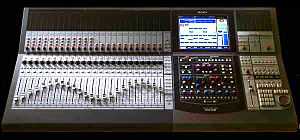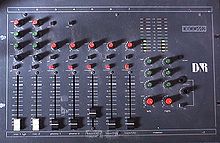- Audio mixing (recorded music)
-
In audio recording, audio mixing is the process by which multiple recorded sounds are combined into one or more channels, most commonly two-channel stereo. In the process, the source signals' level, frequency content, dynamics, and panoramic position are manipulated and effects such as reverb may be added. This practical, aesthetic, or otherwise creative treatment is done in order to produce a mix that is more appealing to listeners.
Audio mixing is done in studios as part of creating an album or single. The mixing stage often follows multitrack recording and the final mixes are normally submitted to a mastering engineer. The process is generally carried out by a mix engineer, also called mixing engineer, or mixer, though sometimes it is the musical producer, or even the artist, who mixes the recorded material.
Prior to the emergence of digital audio workstations (DAWs), the process of mixing used to be carried out on a device known as an audio mixer, sound board, desk, or mixing console. Nowadays, more and more engineers and independent artists are using a personal computer for the process (commonly referred to as mixing in-the-box). Mixing consoles still play a large part in the recording process. They are often used in conjunction with a DAW, although the DAW may only be used as a multitrack recorder and for editing or sequencing, with the actual mixing being performed on the console.
Contents
The role of audio mixing
 An audio production facility at An-Najah National University
An audio production facility at An-Najah National University
The role of music producer is not necessarily a technical one, with the physical aspects of recording being assumed by the audio engineer, and so producers often leave the similarly technical mixing process to a specialist audio mixer. Even producers with a technical background may prefer that a mixer comes in to take care of the final stage of the production process. Noted producer and mixer Joe Chiccarelli has said that it is often better for a project that an outside person comes in because:
"when you're spending months on a project you get so mired in the detail that you can't bring all the enthusiasm to the final [mixing] stage that you'd like. [You] need somebody else to take over those responsibilities so that you can sit back and regain your objectivity."[1]
However, as Chicarelli explains, sometimes limited budgets dictate that a producer takes care of the mixing as well.[1]
History
Mixing as we know it today emerged with the introduction of commercial multitrack tape machines, most notably the 8-track recorders that were introduced during the 1960s. The ability to record sounds into a multitude of channels meant that treating these sounds can be postponed to a later stage – the mixing stage.
In the 1980s, home recording and mixing began to take market share from recording studios. The 4-track Portastudio was introduced in 1979. Using one, Bruce Springsteen released the album Nebraska in 1982. The Eurythmics topped the charts in 1983 with the song "Sweet Dreams (Are Made of This)", recorded by bandmember Dave Stewart on a makeshift 8-track recorder.[2] In the mid-to-late 1990s, computers replaced tape-based recording for most home studios, with the Power Macintosh proving popular.[3] At the same time, digital audio workstations (DAW), first used in the mid-1980s, began to replace tape in many professional recording studios.
Equipment
Mixers
Main article: mixing consoleA mixer, or mixing console, or mixing desk, or mixing board, or software mixer is the operational heart of the mixing process.[4] Mixers offer a multitude of inputs, each is fed by a track from a multitrack recorder; mixers would normally have 2 main outputs (in the case of two-channel stereo mixing) or 8 (in the case of surround).
Mixers offer three main functionalities[4][5]:
- Mixing – summing signals together, which is normally done by a dedicated summing amplifier or in the case of digital by a simple algorithm.
- Routing – allows the routing of source signals to internal buses or external processing units and effects.
- Processing – many mixers also offer on-board processors, like equalizers and compressors.
Outboard gear and plugins
Outboard gear (analog) and software plugins (digital) can be inserted to the signal path in order to extend processing possibilities. Outboard gear and plugins fall into two main categories[4][5]:
- Processors – these devices are normally connected in series to the signal path, so the input signal is replaced with the processed signal (e.g. equalizers).
- Effects – while an effect can be considered as any unit that affects the signal, the term is mostly used to describe units that are connected in parallel to the signal path and therefore they add to the existing sounds, but do not replace them. Examples would include reverb and delay.
Common classes:
- Processors:
- Faders – used to attenuate or boost the level of signals.
- Pan pots – used to pan signal to the left or right and in surround also back and front.
- Equalizers – used to manipulate the frequency content of signals.
- Compressors – used to manipulate the dynamic content of signals. Among many applications they can even the level fluctuations of a singer, or reshape dynamic envelopes of percussive instruments (e.g. adding attack to a snare).
- Gates – used mainly to attenuate low-level signals, for example, the kick spill on a snare recording.
- Effects:
Mixing Domains
The process of mixing often accounts for a few mixing domains[5][6][7]:
- Level – concerned with the relative level between instruments and their dynamics.
- Frequency – concerned with the spectral content of the various instruments and the overall mix.
- Space – concerned with the spatial aspect of the various instruments. The space domain is often further subdivided into two sub-domains:
- Stereo – concerned with the horizontal panoramic (left/right) aspects of instruments.
- Depth – concerned with the front-back aspects of instruments.
Mixing in Surround
Mixing in surround is very similar to mixing in stereo except that there are more speakers, placed to 'surround' the listener. The same mixing domains mentioned above are involved, but instead of stereo's horizontal panoramic aspects, and depth's front-back aspects, mixing in surround lets the mix engineer pan sources within a much more two dimensional environment. In a surround mix, sounds can appear to originate from any direction.
There are two common ways to approach mixing in surround:
- Expanded Stereo – With this approach, the mix will still sound very much like an ordinary stereo mix. Most of the sources such as the instruments of a band, the vocals, and so on, will still be panned between the left and right speakers, but lower levels might also be sent to the rear speakers in order to create a wider stereo image, while lead sources such as the main vocal might be sent to the center speaker. Additionally, reverb and delay effects will often be sent to the rear speakers to create a more realistic sense of space. In the case of mixing a live recording that was performed in front of an audience, signal recorded by microphones aimed at, or placed among the audience will also often be sent to the rear speakers to make the listener feel as if he or she is in the crowd.
- Complete Surround / All Speakers Are Treated Equally – Instead of following the traditional ways of mixing in stereo, this much less conservative approach lets the mix engineer do anything he or she feels like. Instruments can appear to originate from anywhere, or even spin around the listener. When done tastefully, interesting sonic experiences can be achieved, as was the case with James Guthrie's 5.1 mix of Dark Side of the Moon.[8]
Naturally, these two approaches can be combined any way the mix engineer sees fit. Recently, a third approach, or method of mixing in surround was developed by surround mix engineer Unne Liljeblad.
- MSS – Multi Stereo Surround[9] – This approach treats the speakers in a surround sound system as a multitude of stereo pairs. For example, a stereo recording of a piano, created using two microphones in an ORTF configuration, might have its left channel sent to the Left Rear Speaker and its right channel sent to the Center Speaker. The piano might also be sent to a reverb having its left and right outputs sent to the Left Front Speaker and Right Rear Speaker respectively. Additional elements of the song, such as an acoustic guitar recorded in stereo, might have its left and right channels sent to the Left Front Speaker and the Right Rear Speaker with a reverb returning to the Left Rear Speaker and the Center Speaker. Thus, multiple clean stereo recordings surround the listener without the smearing comb filtering effects that often occurs when the same or similar sources are sent to multiple speakers.
See also
References
- ^ a b "Interview with Joe Chiccarelli". HitQuarters. 14 June 2010. http://www.hitquarters.com/index.php3?page=intrview/opar/intrview_Joe_Chiccarelli_Interview.html. Retrieved Sep 3, 2010.
- ^ "Eurythmics: Biography". Artist Directory. Rolling Stone. 2010. http://www.rollingstone.com/music/artist/news/artists/8828/65055/65074. Retrieved March 20, 2010.
- ^ "Studio Recording Software: Personal And Project Audio Adventures". studiorecordingsoftware101.com. 2008. http://www.studiorecordingsoftware101.com/. Retrieved March 20, 2010.
- ^ a b c White, Paul (2003). Creative Recording (2nd ed.). Sanctuary Publishing. pp. 335. ISBN 1-8-6074-456-7.
- ^ a b c Izhaki, Roey (2008). Mixing Audio. Focal Press. pp. 566. ISBN 978-0-240-52068-1.
- ^ Owsinski, Bobby (1999). The Mixing Engineers's Handbook. Intertec Publishing Corporation. pp. 219. ISBN 0-87288-723-5.
- ^ Gibson, David (1997). The Art of Mixing. Mix Books. pp. 127. ISBN 0-918371-17-1.
- ^ http://www.digitalbits.com/reviewsdvdasacd/pinkfloyddarksidesacd.html
- ^ "Surround Sound Mixing". www.mix-engineer.com. http://www.mix-engineer.com/audio-philosophy/surround-sound-mixing/. Retrieved 2010-01-12.
Categories:- Audio mixing
- Sound recording
- Sound production technology
Wikimedia Foundation. 2010.


